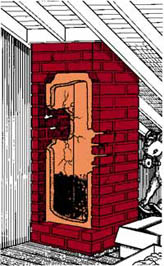A Guided Tour Of Your Chimney

|
Now look inside, see the problems?
When we look at the interior of the same chimney we can find a number of imperfect conditions. Pieces are missing from the original clay liner and there are cracks in the clay liner. (Older chimneys might not even have a liner.) Mortar and bricks are loose and falling. And there is excessive buildup of combustable creosote on the flue walls.
These conditions may be the result of a number of possible causes, including: flue fires, an improperly vented or misused stove, poor chimney construction, excessive moisture, and more.
With continued use of this chimney, any of these conditions could lead to loss of property or life.

|

Chimney Terms
Stainless Steel Chimney Liner
Stainless steel pipe, either rigid or flexible, made for relining flues of masonry chimneys when the original clay liner has cracked or broken. May also be used to create a lining in a masonry chimney that was made without a clay liner.
Chimney Caps
Protective coverings for chimneys usually made of aluminum, galvanized or stainless steel, or copper. Most chimney caps have a mesh screening that serves the dual purpose of spark arrestor and barrier against animals. Chimney caps also prevent rain from entering the flue of the chimney.
Top-Sealing Dampers
A device installed at the top of a chimney for the purpose of sealing the flue shut when the fireplace is not in use. They are often used as replacements for throat dampers that are installed just above the firebox when a masonry chimney is built. Lyemance and Lock-Top top-sealing dampers are as much as 90% more efficient than throat dampers because they provide a silicone rubber gasket seal rather than metal to metal.